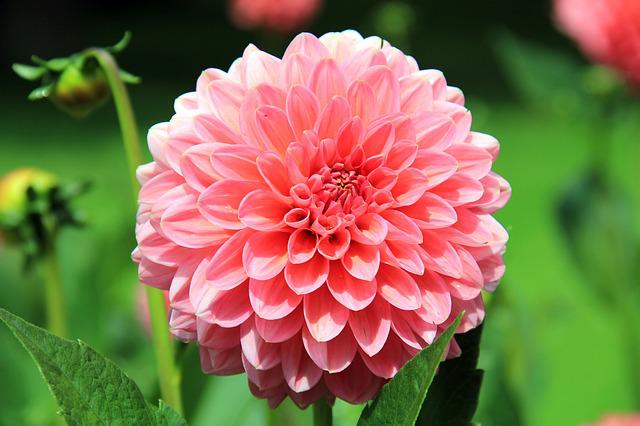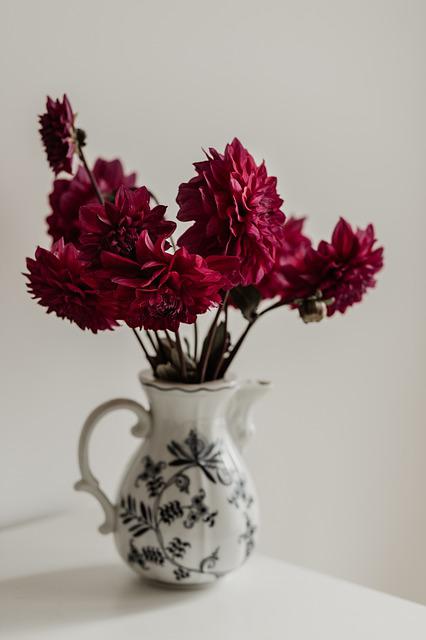Tips For Drying Dahlias: The Ultimate Guide To Know Before You Start!

There is some debate surrounding the drying of Dahlias, but in general, it seems this plant can be successfully dried. You will need to consider a few things when attempting this process: first, ensure your dahlia is cut properly so there are no damaged areas. Next, place the dahlias on paper towels or absorbent material and let them air-dry for several days. Finally, once they’re dry enough (usually within 2-3 weeks), seal them in an oxygen-free environment (such as a jar) until you’re ready to use them.
Table of Contents
Can You Dry Dahlias?
Dahlias can be dried, but it is important to note that they will not retain their color or flavor. The best way to dry dahlias is by placing them on a screen in an airtight container and leaving them in the sun for several days. Alternatively, you can use an oven set at 225°F for 30-60 minutes. Do not try to freeze dahlias. Doing so may cause them to become spoiled and gummy.
Different Ways to Dry Flowers
Drying by Air
Air drying is the best way to dry flowers. Remove the leaves from the flowers and tie together several stems. Take a rubber band and slide it over 2–3 stems. Then, wrap the rubber band around the whole bunch of stems several times, sliding it over two or three more stems near the end of the bunch. It will look like you wrapped a wire around the stems with the rubber band. Do not pack flowers too tightly or too thickly; you will make damp spots that will cause them to rot.
Make an S-shape with a paper clip by pulling it apart. Hook one end to the flower bunch’s coiled rubber band and the other to a coat hanger. Hang the coat hanger with the flowers until they are dry in a warm, dry closet or attic. The drying time will depend on how thick the flower stems are, how humid the air is, how big the bundle is, and how hot it is (anywhere from 3 days to 3 weeks).
Flowers with thick stems can also be dried by standing them up in a can or jar. Flowers dried by hanging won’t have straight stems, but this may make your dried flower arrangement look more natural. I take care of hydrangeas this way.
Foliage is always taken off when something is air-dried because the leaves tend to curl and look bad. A simple way to dry leaves is to lay them flat on an old window screen and cover them with newspaper. This keeps the leaves from curling as they dry.
Pressing
Dried flowers can be pressed directly. First, remove the leaves from the stems by snipping them off with scissors and laying them on a flat surface such as cardboard cutout or old magazine pages without clipping any bracts that are still attached to the flower.
Pressing flowers is the traditional way to dry them. A simple flower press can be bought or made by putting two thin pieces of wood together with bolts at each corner. Then, put cardboard and unbleached paper sheets between the wood pieces.
Ensure the flowers don’t touch each other when you put them in your flower press. About 30 days will pass before your flowers are dry.
Flowers that are thin or flat are the best ones to press. You can also fold the flowers onto a separate piece of paper and put that in the book. This might make it less likely that your book will get dirty.
Put the book back on the shelf with other books on either side or at the bottom of a big pile of books, which will do the trick.
If you want to press dahlias, try to find ones that aren’t as full in the middle or look like pom-poms. The big dahlias that look like dinner plates will press better, but you’ll need a big enough press and some patience.
Silica Gel
Air drying works well for tiny flowers, but it often dries out large, delicate blooms so much that they can’t be recognized. When dried with a desiccant, roses, peonies, dahlias, sunflowers, lilacs, zinnias, hyacinths, and daffodils do much better.
Silica gel is one of the easiest and most effective ways to stop moisture from getting in. Silica gel is not a gel; it looks like blue crystals in white sand. Once the gel’s saturation point is reached, the crystals turn pink.
- You will need a plastic jar with a lid to dry these flowers.
- Fill the empty container with an inch of silica gel.
- When cutting your dahlia stems, leave about an inch of stem from the bloom.
- Place your blooms in a container that is at least 2 inches taller than they are, face up. Because moisture can get inside wooden or cardboard containers, don’t use them.
- Use a measuring scoop to slowly spread silica gel over the flowers, stem, and leaves.
- Pour silica gel over your flowers until they’re covered by at least an inch of silica gel. To keep your container airtight, cover it with a lid or saran wrap and store it in a dark place for 7 days.
- If your container is deep enough, you can put two layers of flowers in it to keep them alive. It takes between 2 and 7 days for flowers to dry.
- When the time comes, carefully remove your flowers because the petals will be dry and crisp.
- You could either gently pour off the silica gel or use a slotted spoon to remove the blooms to see if they are ready.
- To seal your blooms and keep moisture out, spray them with hairspray or use Modge Podge.
- Spray a surface sealer on dried flowers to keep them from getting wet or falling apart. Spray flowers outside and let them dry on a piece of wax paper. Use floral wire, tape, or a hot glue gun to put the flowers and stems back together.
- It can be hard to put the flower back together. The straightforward idea is to use floral wire and tape to make a stem. Put the wire into the flower about 1/4 inch and wrap it with green floral tape.
- If that doesn’t work, you can glue or tape the stem and leaves back together. If you took the leaves off the stem, you can cut small pieces of floral wire and put them where the leaves used to be. This should be done while the stem is still fresh. After it’s dry, put hot glue on the wire and place the leaf on it. Do this, again and again, to connect the flower to the stem. When putting the flower back together, put the stem in OasisTM florist foam, so you don’t hurt the flower or leaves.
- To use silica gel again, put it in a glass baking dish and heat it in the oven for an hour at 275°F. You can get all of these things at craft stores.
- Silica gel is expensive. Use 40% borax and 60% white cornmeal as an alternative that will save you money. The flowers need more time to dry with this recipe, so leave them in the container for two weeks.
Sand
In the past, people used sand to dry flowers. When buried in fine, dry sand, many flowers stay fresh for a long time. Some of the best flowers to dry this way are both marigolds and zinnias, both strong.
- Fill a cardboard box with 2 inches of sand. If you want to dry a flower from the daisy family, put it on the sand upside down. Pour about an inch of sand around it, so the base is covered. Don’t let any of the flowers touches.
- When the stems are out in the air, they will dry. Remember to get rid of the leaves, or they will curl. Put it in a warm, dry place and leave it there for about 5–10 days. Dust off the sand and take the flowers away.
Drying Flowers in Microwave
If you don’t have much time, you can speed up the drying process with a microwave. Any of these ways of using the microwave will take some time to get used to. To dry the flowers without burning them is the key. For this method to work, you need to know how powerful your microwave is and how it will affect the flowers you are drying. If you try it out a few times, it should get easier.
- If you want to dry flowers in the microwave with silica crystals, use a container that can go in the microwave but doesn’t have a lid.
- Just like the regular silica gel method, put the flowers in the container.
- Make sure there is an inch of crystals under the flowers and all over the flowers as well.
- Make sure there is space between the flowers and that none of them are touching.
- Put a cup of water and the vase of flowers in the microwave.
- Heat on medium heat for one minute at a time.
- Between each step, let it cool for 20 to 30 minutes.
- Keep an eye on the flowers at all times.
- If the flowers are almost dry but still need a little more time, you might let them finish drying in the silica gel at room temperature so that the petals don’t get burned.

Drying in a Vase
This is among the easiest methods for drying flowers. As they are placed in the vase, the flowers will naturally dry. You can appreciate the entire process, beginning with placing the flowers in the vase. Using this method requires minimal or no cleanup.
- Put water and fresh flowers into the vase.
- Allow the flowers to absorb the water, and do not add more water to the vase once it has been completely absorbed.
- Allow the flowers to dry in the vase as they sit.
- Within a few weeks, they will have been properly dried and preserved.
Oven-Drying
As long as your oven can be set to a low temperature, oven drying will expedite the drying process. This method can be effective for mass-drying petals.
- Adjust the oven temperature to its lowest setting.
- Select and remove the stems from your flowers.
- Place the flowers on a baking rack, then place this rack on a baking sheet in the oven.
- Check on the flowers every two to twelve hours throughout the baking process.
- If the oven becomes humid, crack the door open slightly to allow the moisture to escape.
- Remove the dried flowers and allow them to cool before storing them completely.
Dehydrator
Using a dehydrator, multiple small flowers and petals can be dried at once. This drying method reduces the fire risk and can be completed quickly compared to other drying techniques.
- The best way to dry flowers in a dehydrator is at the lowest temperature and for the longest time.
- Place the flowers on the drying racks, ensuring that they are not touching, as touching can cause them to dry stuck together.
- Turn on the dehydrator and allow the food to dry for between twelve and twenty-four hours.
- Check the flowers periodically and remove them from the dehydrator when they have dried completely.
